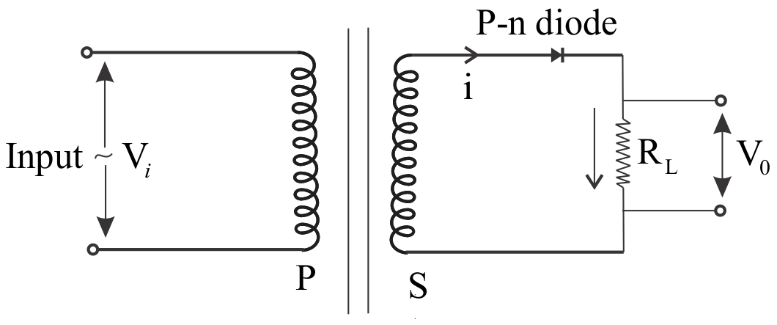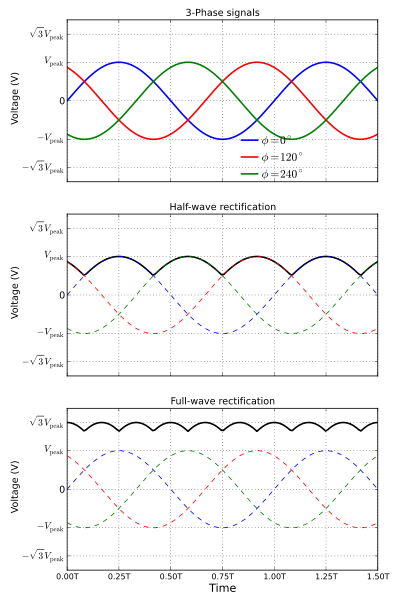
How is a p-n junction diode used as a half wave rectifier? Explain its working, draw a neat circuit diagram. Show the waveforms of input and output voltages.
Answer
435.5k+ views
Hint: A p-n junction diode can work as an excellent rectifier since it offers a low resistance for the current to flow when it is forward biased; but a very high resistance when reverse biased. Thus, it allows current through it only in one direction and acts as a rectifier.
Complete step by step answer:
Basically, a rectifier is a device which converts an alternating current into a direct current. A half-wave rectifier consists of a transformer, a diode and a load resistor. The primary coil of the transformer is connected to the ac mains, and the secondary coil to a load resistor $${{\text{R}}_{\text{L}}}$$ through the diode D as shown below in figure: -

The waveforms of input and the corresponding output voltages are as shown below:-

During the positive half-cycle of the input voltage sine wave, the p-n junction diode is forward-biased and hence it conducts through ${{\text{R}}_{\text{L}}}$. The current flowing in the circuit produces a voltage across the load which has the same shape as the positive half-cycle of the input voltage ${{\text{V}}_{\text{i}}}$. During the next half-cycle of the sine wave, the p-n junction diode is reverse-biased. Hence, during this time, no current flows in the circuit and no voltage develops across ${{\text{R}}_{\text{L}}}$. Since only the positive half-cycle of the input appears across the load, the input ac voltage is converted into a pulsating dc voltage. This process is repeated. This process is called Half-Wave Rectification.
Note: The purpose of the transformer is to supply the necessary voltage to the rectifier. It may be a step-up or step-down depending on the requirement. The ratio of RMS value of AC component to DC component in the rectifier is called ripple factor.
Complete step by step answer:
Basically, a rectifier is a device which converts an alternating current into a direct current. A half-wave rectifier consists of a transformer, a diode and a load resistor. The primary coil of the transformer is connected to the ac mains, and the secondary coil to a load resistor $${{\text{R}}_{\text{L}}}$$ through the diode D as shown below in figure: -

The waveforms of input and the corresponding output voltages are as shown below:-

During the positive half-cycle of the input voltage sine wave, the p-n junction diode is forward-biased and hence it conducts through ${{\text{R}}_{\text{L}}}$. The current flowing in the circuit produces a voltage across the load which has the same shape as the positive half-cycle of the input voltage ${{\text{V}}_{\text{i}}}$. During the next half-cycle of the sine wave, the p-n junction diode is reverse-biased. Hence, during this time, no current flows in the circuit and no voltage develops across ${{\text{R}}_{\text{L}}}$. Since only the positive half-cycle of the input appears across the load, the input ac voltage is converted into a pulsating dc voltage. This process is repeated. This process is called Half-Wave Rectification.
Note: The purpose of the transformer is to supply the necessary voltage to the rectifier. It may be a step-up or step-down depending on the requirement. The ratio of RMS value of AC component to DC component in the rectifier is called ripple factor.
Recently Updated Pages
Difference Between Circuit Switching and Packet Switching

Difference Between Mass and Weight

JEE Main Participating Colleges 2024 - A Complete List of Top Colleges

JEE Main Maths Paper Pattern 2025 – Marking, Sections & Tips

Sign up for JEE Main 2025 Live Classes - Vedantu

JEE Main 2025 Helpline Numbers - Center Contact, Phone Number, Address

Trending doubts
JEE Main 2025 Session 2: Application Form (Out), Exam Dates (Released), Eligibility, & More

JEE Main 2025: Derivation of Equation of Trajectory in Physics

JEE Main Exam Marking Scheme: Detailed Breakdown of Marks and Negative Marking

Learn About Angle Of Deviation In Prism: JEE Main Physics 2025

Electric Field Due to Uniformly Charged Ring for JEE Main 2025 - Formula and Derivation

JEE Main 2025: Conversion of Galvanometer Into Ammeter And Voltmeter in Physics

Other Pages
Units and Measurements Class 11 Notes: CBSE Physics Chapter 1

JEE Advanced Marks vs Ranks 2025: Understanding Category-wise Qualifying Marks and Previous Year Cut-offs

NCERT Solutions for Class 11 Physics Chapter 1 Units and Measurements

Motion in a Straight Line Class 11 Notes: CBSE Physics Chapter 2

Important Questions for CBSE Class 11 Physics Chapter 1 - Units and Measurement

NCERT Solutions for Class 11 Physics Chapter 2 Motion In A Straight Line




